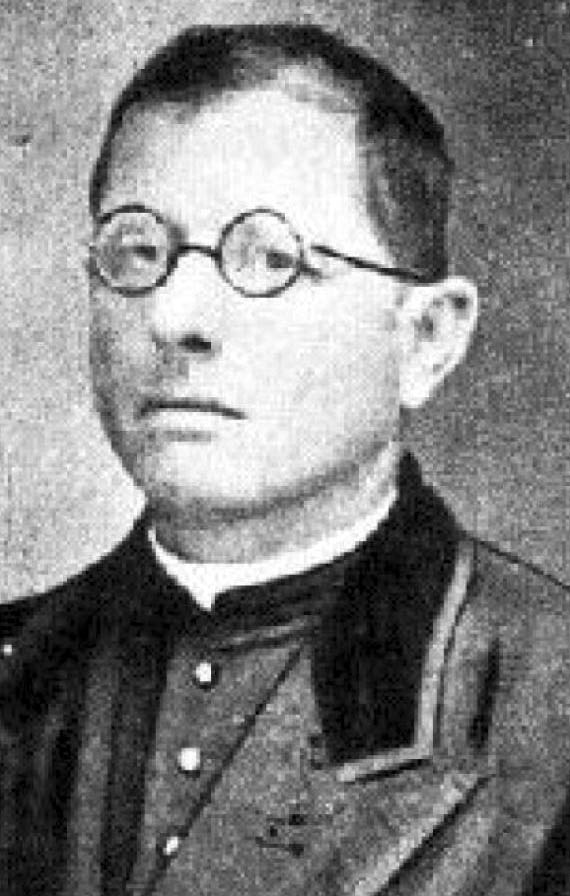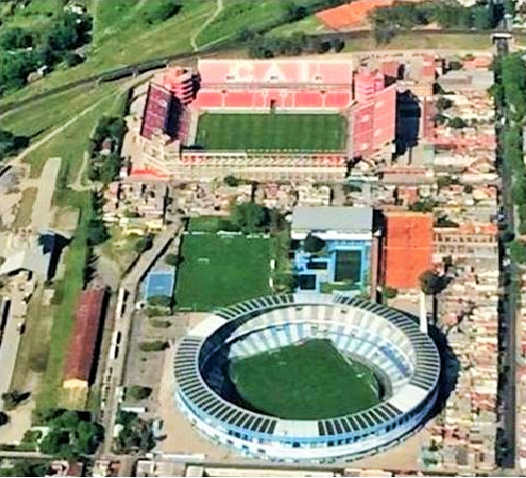|
San Lorenzo De Almagro
Club Atlético San Lorenzo de Almagro, commonly known as San Lorenzo de Almagro or simply San Lorenzo (in English: ''Saint Lawrence''), is a sports club of Argentina in the Boedo district of Buenos Aires. It is best known for its football team, which plays in the Primera División, the first tier of the Argentinian football league system. San Lorenzo is also considered one of the " big five" (''"Los 5 Grandes"'') of Argentinian football, along with Independiente, River Plate, Boca Juniors, and Racing Club. San Lorenzo plays its home games at Estadio Pedro Bidegain, popularly known as ''Nuevo Gasómetro''. The stadium and sports facilities are located in the Bajo Flores district of the Buenos Aires. The club's previous stadium was the '' Viejo Gasómetro'', located in Boedo. In 1979, the ''Gasómetro'' was expropriated by the de facto Government of Argentina and then sold to supermarket chain Carrefour. The club currently has six headquarters: three in Boedo, one in Mon ... [...More Info...] [...Related Items...] OR: [Wikipedia] [Google] [Baidu] |
Gaucho
A gaucho () or gaúcho () is a skilled horseman, reputed to be brave and unruly. The figure of the gaucho is a folk symbol of Argentina, Uruguay, Rio Grande do Sul in Brazil, and the south of Chilean Patagonia. Gauchos became greatly admired and renowned in legend, folklore, and literature and became an important part of their regional cultural tradition. Beginning late in the 19th century, after the heyday of the gauchos, they were celebrated by South American writers. The gaucho in some respects resembled members of other nineteenth century rural, horse-based cultures such as the North American cowboy ( in Spanish), of Central Chile, the Peruvian or , the Venezuelan and Colombian , the Ecuadorian , the Hawaiian , the Mexican , and the Portuguese . According to the , in its historical sense a gaucho was a "mestizo who, in the 18th and 19th centuries, inhabited Argentina, Uruguay, and Rio Grande do Sul in Brazil, and was a migratory horseman, and adept in cattle work". In Argen ... [...More Info...] [...Related Items...] OR: [Wikipedia] [Google] [Baidu] |
Estadio Gasómetro
The San Lorenzo de Almagro Stadium (popularly known as Estadio Gasómetro)San Lorenzo y el Gasómetro, un exilio de 40 años by Cristian Dellocchio on Página/12, 2 Dec 2019 was a located in the of in |
Field Hockey
Field hockey is a team sport structured in standard hockey format, in which each team plays with ten outfield players and a goalkeeper. Teams must drive a round hockey ball by hitting it with a hockey stick towards the rival team's shooting circle and then into the goal. The match is won by the team that scores the most goals. Matches are played on grass, watered turf, artificial turf, synthetic field, or indoor boarded surface. The stick is made of wood, carbon fibre, fibreglass, or a combination of carbon fibre and fibreglass in different quantities. The stick has two sides; one rounded and one flat; only the flat face of the stick is allowed to progress the ball. During play, goalkeepers are the only players allowed to touch the ball with any part of their body. A player's hand is considered part of the stick if holding the stick. If the ball is "played" with the rounded part of the stick (i.e. deliberately stopped or hit), it will result in a penalty (accidental touches ar ... [...More Info...] [...Related Items...] OR: [Wikipedia] [Google] [Baidu] |
San Lorenzo De Almagro (basketball)
Club Atlético San Lorenzo de Almagro is the men's professional club basketball section of the homonymous sports club based in Buenos Aires, Argentina. The team plays in the Liga Nacional de Básquet (LNB), which is the first tier level division of the Argentine basketball league system, and Pan-America's premier men's basketball league, the Basketball Champions League Americas. Their home arena is the Estadio Ciudad de Santiago del Estero. The team is currently coached by Silvio Santander. In the period 1942-1973, he stood out for what he did at the amateur and semi-amateur level, in which he won 29 regional titles, won the Argentine Club Championship, and was South American runner-up in 1958. In addition, he was one of the founding clubs of the National League, playing the opening game of said tournament on April 26, 1985. Although the club is known mainly for its soccer part, it is also one of the most important basketball clubs in the country and South America, being a multi ... [...More Info...] [...Related Items...] OR: [Wikipedia] [Google] [Baidu] |
Artistic Roller Skating
Artistic roller skating is a sport similar to figure skating but where competitors wear roller skates instead of ice skates. Within artistic roller skating, there are several disciplines: * Figures: the individual follows the figure circle line on a specific edge. Figures become progressively more complex with the addition of turns and the use of the third circle (similar to compulsory or "school" figures on ice). * Freestyle: the individual performs a solo routine with jumps and spins to their chosen piece of music. * Duo Free (also called Pairs): two individuals perform jumps, spins, and lifts to their chosen piece of music. * * Couples Compulsory Dance: two people perform a dance consisting of a set sequence of steps in a pattern around the rink to a piece of music to a given tempo. There are no jumps or spins. * Solo Compulsory Dance: an individual performs a dance consisting of a set series of steps in a pattern around the rink to a piece of music to a given tempo. There a ... [...More Info...] [...Related Items...] OR: [Wikipedia] [Google] [Baidu] |
Clásico De Avellaneda
The Avellaneda derby ( es, Clásico de Avellaneda) is the second-most important rivalry in Argentine football. It is contested between Independiente and Racing Club. It is the second-most important local derby, behind the ''Superclásico'' contested between Boca Juniors and River Plate, which are both based in the city of Buenos Aires. The Avellaneda derby is a major football rivalry. Both teams are very popular in Argentina, and are two of the " five big teams of Argentinian football." History Both clubs were founded in the early years of the 20th century, Racing on 25 March 1903 and Independiente on 1 January 1905. Independente were founded in Buenos Aires and moved to Avellaneda in 1907. * The first encounter between Independiente and Racing (reserve teams) was on 9 June 1907, with Independiente winning 3–2 when both clubs were competing in lower divisions. Independiente wore a white with blue pocket shirt while Racing wore a squared pink and light blue shirt (both wer ... [...More Info...] [...Related Items...] OR: [Wikipedia] [Google] [Baidu] |
Superclásico
Superclásico is the football match in Argentina between Buenos Aires rivals Boca Juniors and River Plate. It derives from the Spanish usage of "clásico" to mean derby, with the prefix "super" used as the two clubs are the most popular and successful clubs in Argentine football. In fact, the term 'Clásico' originated in Argentina, particularly with this match up and it was later exported to other countries such as Spain and Mexico. According to some statistics, they commandeer more than 70% of all Argentine football fans between them. The Superclásico is known worldwide as one of the fiercest and most important derbies. In April 2004, the English newspaper ''The Observer'' put the Superclásico at the top of their list of "50 sporting things you must do before you die", saying that "Derby day in Buenos Aires makes the Old Firm game look like a primary school kick-about", and in 2016 the British football magazine ''FourFourTwo'' considered it the "biggest derby in the world ... [...More Info...] [...Related Items...] OR: [Wikipedia] [Google] [Baidu] |
Parque Patricios
Parque Patricios is a ''barrio'' located on the southern side of Buenos Aires, Argentina belonging to the fourth ''comuna''. Parque Patricios underwent a transformation during the beginning of the 1900s. The government moved the main slaughterhouse to Mataderos, removed refuse piles and the notorious trash incinerators ("la quema") and the cemetery used during the 1871 yellow fever epidemic, now Parque Ameghino. Parks, a zoo and hospitals were put in their place. Parque Patricios received its name from the park of the same name, designed by Carlos Thays, the French architect who designed many of the most distinctive parks in the north of the city including the Botanical Garden and Bosques de Palermo. This barrio features many hospitals which treat patients from all parts of Argentina, as well as the notorious former Caseros Prison. It is also the home of Club Atlético Huracán, a First Division football team, and their stadium Estadio Tomás Adolfo Ducó. Parque Patricios is ... [...More Info...] [...Related Items...] OR: [Wikipedia] [Google] [Baidu] |
Club Atlético Huracán
Club Atlético Huracán () is an Argentine sports club from the Parque Patricios neighbourhood of Buenos Aires. The club is notable for its football team, that currently plays in the Primera División, the top level of the Argentine football league system. Its home stadium is the Estadio Tomás Adolfo Ducó. Huracán was founded on 1 November 1908 in the Nueva Pompeya neighbourhood of Buenos Aires. The club's name and nickname (''Globo'', literally "Balloon") comes from the ''Huracán'' ("Hurricane") balloon flown by Jorge Newbery in 1909. Its supporters are called ''los Quemeros'' ("the Burners") because the stadium is located in a former garbage burning area. Since its establishment, Huracán has won 13 domestic titles (including five Primera División championships, and most recently the 2014 Supercopa Argentina). Apart from those achievements, the team has finished as runner-up of the top division seven times (the last one in the 2009 Clausura). Huracán's historical r ... [...More Info...] [...Related Items...] OR: [Wikipedia] [Google] [Baidu] |
Ezeiza, Buenos Aires
Ezeiza () is the capital city of the Ezeiza Partido within the Greater Buenos Aires area in Argentina. The city had a population of 160,219 in 2010. Ezeiza is one of the fastest-growing cities in Argentina; the city and its surroundings are known for the many gated communities there, as well as for the Ministro Pistarini International Airport and the Ezeiza Federal Prison Complex. Ezeiza and its surrounds are known as affluent areas. History Inhabited originally by the Querandí people, the land was then claimed by the Conquistadores in 1588. The first estancia (''Los Remedios'') and chapel in the area were founded by Juan Guillermo González y Aragón in 1758; one of González's great-grandsons was Manuel Belgrano, one of the most notable leaders of the Argentine War of Independence. Gerónimo Ezeiza bought land nearby in 1767, and by the late 19th century his descendant José María Ezeiza became the largest landowner in the area. Following his death, Ezeiza's son-in-law do ... [...More Info...] [...Related Items...] OR: [Wikipedia] [Google] [Baidu] |
Villa Gesell
Villa Gesell is a seaside resort city in Villa Gesell Partido, Buenos Aires Province, Argentina. It was founded in 1931, with the intention of turning a dune field into a timber plantation.Historia de Villa Gesell The growth of the city allowed it to annex the nearby cities of Mar de las Pampas, Las Gaviotas and . History [...More Info...] [...Related Items...] OR: [Wikipedia] [Google] [Baidu] |
Monserrat, Buenos Aires
Monserrat or Montserrat () is a neighbourhood in the east of the Buenos Aires CBD. The district features some of the most important public buildings in Buenos Aires, including city hall, the city legislature, Casa Rosada, the Colegio Nacional de Buenos Aires and the Libertador Building (Ministry of Defense), among others. Avenida de Mayo runs through the Monserrat district, connecting Plaza de Mayo and the Plaza de los Dos Congresos (Congressional Plaza). A block, or two, south of the Plaza de Mayo, the older section of Monserrat begins. This is Buenos Aires' oldest neighborhood and even today, very little of the cityscape there is less than a hundred years old (except along Belgrano Avenue), thereby making a nearly seamless transition to the likewise historic San Telmo district, to the south. History The Monserrat area traces its origins to the foundation of Buenos Aires itself, when, in 1580, Spanish Adelantado Juan de Garay disembarked on the area's shores. The Fort ... [...More Info...] [...Related Items...] OR: [Wikipedia] [Google] [Baidu] |








